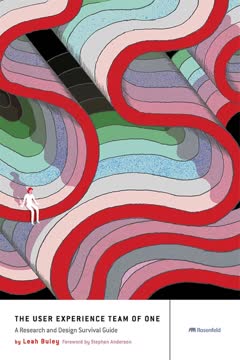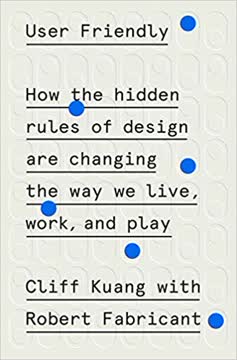Key Takeaways
1. Stories are powerful tools for user experience design
Stories are a way of connecting what you know about those people (your users) to the design process, even if they can't always be part of your team.
Stories humanize data. They help UX designers ground their work in real contexts, illustrating how users interact with products and services. By creating narratives around user experiences, designers can better understand and empathize with their target audience. Stories also serve as effective communication tools, allowing designers to:
- Convey complex ideas in relatable ways
- Spark innovation and collaboration
- Create a shared sense of purpose among team members
- Persuade stakeholders of the value of UX contributions
Stories in UX design can take many forms, including personas, scenarios, user journeys, and anecdotes from user research. These narratives help bridge the gap between raw data and actionable insights, making the design process more user-centered and effective.
2. Effective storytelling starts with active listening
Remember: Stories start with listening.
Listen deeply to users. Active listening is a crucial skill for UX designers to gather authentic stories from users. This involves not just hearing words, but also observing non-verbal cues, emotions, and contextual details. To become a better listener:
- Give users your undivided attention
- Use open-ended questions to encourage storytelling
- Practice empathy and avoid interrupting
- Look for patterns and themes across multiple user stories
By honing listening skills, designers can uncover valuable insights that might not be apparent through traditional research methods. These stories can then be used to inform design decisions, create more accurate personas, and develop user-centered solutions.
3. Ethical considerations are crucial when using real people's stories
A good story weaves together causes and effects in a narrative so you can best remember them. It captures context and tacit knowledge and does so more efficiently than any other form of communication.
Respect user privacy and dignity. When using real people's stories in UX design, it's essential to maintain ethical standards. This includes:
- Obtaining informed consent from participants
- Protecting user anonymity when necessary
- Accurately representing user experiences without exaggeration or distortion
- Considering the potential impact of sharing stories on individuals and communities
Designers must strike a balance between telling compelling narratives and respecting the privacy and dignity of the people involved. This ethical approach not only protects users but also maintains the integrity and credibility of the design process.
4. Stories can be integrated into all stages of the UX process
Stories can be used in many ways throughout any user experience process.
Incorporate stories throughout the design cycle. Stories are versatile tools that can enhance various stages of the UX process:
- User research: Collect and analyze user stories to understand needs and pain points
- Ideation: Use stories to inspire new design concepts and solutions
- Design: Create scenarios and user journeys to guide design decisions
- Evaluation: Develop story-based usability tasks to test designs
- Presentation: Share user stories to communicate design rationale to stakeholders
By integrating stories into each phase, designers can maintain a user-centered focus and ensure that the final product meets real user needs and expectations.
5. Crafting stories requires careful consideration of audience and perspective
When you craft a story, you are choosing a subset of all of the experiential possibilities.
Tailor stories to your audience. Effective storytelling in UX design involves adapting narratives to resonate with specific audiences, such as:
- Technical experts
- Business stakeholders
- Design team members
- End-users
Consider the following elements when crafting UX stories:
- Perspective: Choose a point of view that best conveys the user experience
- Characters: Develop relatable and authentic personas
- Context: Provide relevant details about the user's environment and situation
- Imagery: Use vivid descriptions to help the audience visualize the experience
- Language: Adapt your tone and vocabulary to suit your audience
By carefully selecting these story elements, designers can create more engaging and impactful narratives that effectively communicate user needs and design solutions.
6. Story structure and plot enhance the impact of UX narratives
Story structure provides familiarity to the storytelling process. But that doesn't mean each story has to be the same.
Use familiar structures creatively. Employing recognized story structures can help audiences engage with and remember UX narratives more easily. Some effective structures for UX stories include:
- Hero's journey: Illustrate how a user overcomes challenges using a product
- Familiar to foreign: Start with known concepts and gradually introduce new ideas
- Framed stories: Begin and end with similar situations to show transformation
- Layered stories: Build complexity gradually to reveal insights
While using these structures, maintain flexibility to adapt to the specific needs of your UX project and audience. A well-structured story can make complex design concepts more accessible and memorable.
7. Various mediums can be used to tell compelling UX stories
Stories don't have to be just words.
Explore diverse storytelling formats. UX designers can leverage various mediums to convey user stories effectively:
- Oral storytelling: Use in presentations and workshops to engage audiences
- Written narratives: Incorporate in reports and design documentation
- Visual stories: Create storyboards, comics, or infographics
- Multimedia presentations: Combine text, images, and video for immersive experiences
Each medium has its strengths and can be chosen based on the story's purpose, audience, and context. By diversifying storytelling approaches, designers can cater to different learning styles and increase the impact of their UX narratives.
Last updated:
FAQ
What's Storytelling for User Experience about?
- Focus on storytelling in UX: The book emphasizes the role of storytelling in user experience design, showing how narratives can enhance understanding and engagement with users.
- Practical applications: It offers practical ideas for using stories throughout the UX process, from user research to design evaluation.
- Real-world examples: The authors provide real stories from various projects, demonstrating different storytelling styles and their effectiveness in improving user experience.
Why should I read Storytelling for User Experience?
- Enhance communication skills: The book helps UX practitioners improve their ability to communicate insights and design ideas effectively through storytelling.
- User-centered design focus: It emphasizes keeping users at the center of the design process, crucial for creating meaningful and effective products.
- Diverse audience: Whether you're a beginner or an experienced designer, the book offers valuable insights and techniques that can enrich your practice.
What are the key takeaways of Storytelling for User Experience?
- Stories as tools: Stories are powerful tools for gathering insights, illustrating user needs, and fostering collaboration among team members.
- Iterative process: The storytelling process is iterative, evolving through different stages of design, from brainstorming to evaluation.
- Ethical storytelling: The book discusses the ethical considerations of using real user stories, emphasizing authenticity and respect for users.
How does Storytelling for User Experience define storytelling in user experience design?
- Narrative as a tool: Storytelling is defined as a powerful tool for conveying user experiences, insights, and design concepts in a relatable manner.
- Engagement through empathy: It fosters empathy by allowing designers to see the world through users' eyes, leading to more user-centered design solutions.
- Connection and understanding: Stories create connections between the storyteller and the audience, facilitating a deeper understanding of design challenges and user needs.
How can I start using stories in my UX design process according to Storytelling for User Experience?
- Collect user stories: Begin by gathering stories during user research, focusing on users' experiences, motivations, and challenges.
- Listen actively: Pay attention to the details and emotions in users' narratives, as these can provide valuable insights for your design.
- Incorporate stories into tasks: Use the collected stories to create scenarios for usability testing, ensuring that tasks reflect real user contexts.
What is the Story Triangle mentioned in Storytelling for User Experience?
- Three key elements: The Story Triangle consists of the storyteller, the story itself, and the audience, highlighting their interdependent relationships.
- Interactive storytelling: Good storytelling is interactive, engaging the audience and allowing them to connect with the narrative on a personal level.
- Audience involvement: The effectiveness of a story depends on how well it resonates with the audience, making it essential to tailor stories to their perspectives.
What are generative stories in the context of Storytelling for User Experience?
- Idea generation: Generative stories are used during brainstorming sessions to inspire new design ideas and solutions.
- Focus on user needs: They help keep the design process grounded in real user needs and experiences, ensuring that solutions are relevant.
- Encourage creativity: By using story fragments, teams can explore various possibilities and encourage out-of-the-box thinking.
How can I evaluate my design using stories as suggested in Storytelling for User Experience?
- Create usability tasks: Use stories to develop scenarios for usability testing, ensuring that tasks reflect real user experiences and goals.
- Collect new stories: Gather stories during usability tests to gain insights into how users interact with the design and identify areas for improvement.
- Use stories for reviews: Incorporate stories into design reviews to illustrate user experiences and highlight potential issues or successes.
What ethical considerations should I keep in mind when using stories according to Storytelling for User Experience?
- Respect user privacy: Ensure that you treat users' stories with respect, maintaining their anonymity and confidentiality when necessary.
- Authenticity and honesty: Strive to tell stories that accurately reflect users' experiences and emotions, avoiding exaggeration or distortion.
- Informed consent: Always obtain informed consent from users before sharing their stories, making sure they understand how their information will be used.
What are some effective storytelling techniques mentioned in Storytelling for User Experience?
- Active listening: Engage in active listening during user interviews to capture rich, detailed stories that reveal deeper insights.
- Use of analogies: Employ analogies and relatable examples to make complex ideas more accessible and engaging for your audience.
- Encourage participation: Foster an environment where team members feel comfortable sharing their own stories, enhancing collaboration and creativity.
What are some effective story structures mentioned in Storytelling for User Experience?
- Hero's Journey: This structure involves a protagonist who faces challenges and ultimately grows from the experience, making it relatable and engaging for audiences.
- Prescriptive structures: These are fill-in-the-blank templates that help organize stories logically, ensuring that key elements are included to convey the intended message.
- Framed stories: This structure begins and ends in the same place, creating a sense of closure while highlighting the character's growth or change throughout the narrative.
What are the best quotes from Storytelling for User Experience and what do they mean?
- “A good story for managing has the following criteria: Has a clear point.”: This emphasizes that effective stories should have a focused message that guides the audience's understanding and decision-making.
- “Stories get better with practice.”: This highlights the importance of refining storytelling skills through repetition and feedback, suggesting that storytelling is a craft that improves over time.
- “The relationship between the audience and the story is crucial.”: This underscores the need to consider how the audience perceives the story, which can influence their engagement and interpretation.
Review Summary
Storytelling for User Experience receives mixed reviews, with an average rating of 3.74/5. Some readers find it insightful and practical for UX professionals, praising its exploration of storytelling techniques in design. Others criticize it for being verbose, repetitive, and lacking practical application. Positive reviews highlight its value for understanding user research and sharing findings, while negative reviews cite excessive focus on storytelling basics and insufficient UX-specific content. The book's structure and pacing are points of contention, with some finding it well-organized and others struggling to maintain interest throughout.
Similar Books








Download PDF
Download EPUB
.epub digital book format is ideal for reading ebooks on phones, tablets, and e-readers.




